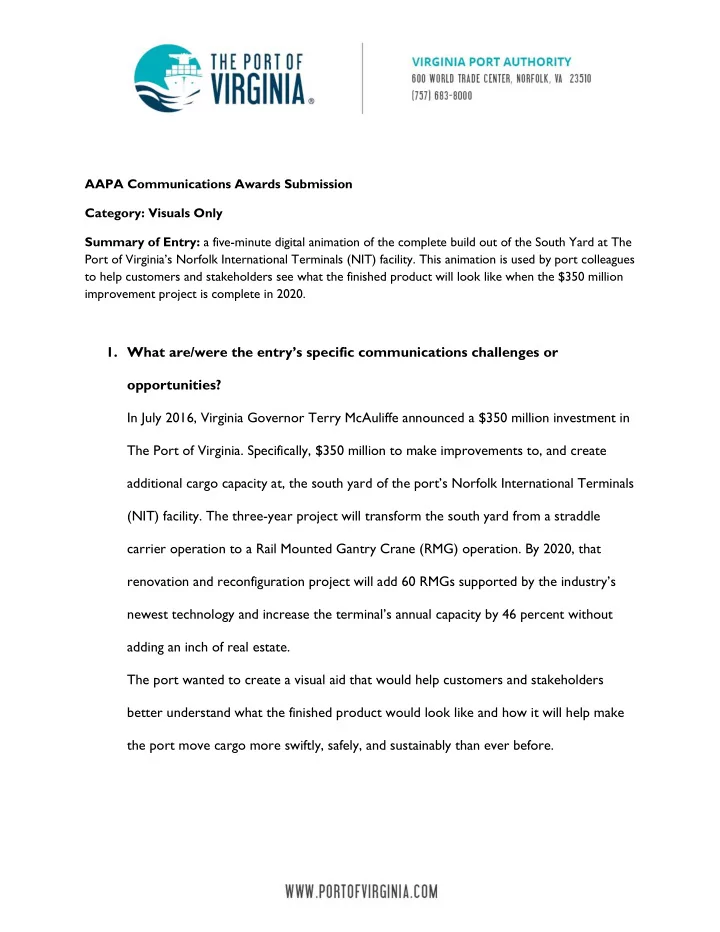

AAPA Communications Awards Submission Category: Visuals Only Summary of Entry: a five-minute digital animation of the complete build out of the South Yard at The Port of Virginia’s Norfolk International Terminals (NIT) facility. This animation is used by port colleagues to help customers and stakeholders see what the finished product will look like when the $350 million improvement project is complete in 2020. 1. What are/were the entr y’s specific communications challenges or opportunities? In July 2016, Virginia Governor Terry McAuliffe announced a $350 million investment in The Port of Virginia. Specifically, $350 million to make improvements to, and create additional cargo capacity a t, the south yard of the port’s Norfolk International Terminals (NIT) facility. The three-year project will transform the south yard from a straddle carrier operation to a Rail Mounted Gantry Crane (RMG) operation. By 2020, that renovation and reconfigurat ion project will add 60 RMGs supported by the industry’s newest technology and increase the terminal’s annual capacity by 46 percent without adding an inch of real estate. The port wanted to create a visual aid that would help customers and stakeholders better understand what the finished product would look like and how it will help make the port move cargo more swiftly, safely, and sustainably than ever before.
2. How does the communication used in this entry complement the organization’s overall mission? Th e Port of Virginia’s mission is as follows: Guided by our company values, The Port of Virginia will achieve our shared vision of operational excellence, fiscal responsibility, and sustainable growth. Above all, we will remain responsible members of the communities we serve, a valuable resource to our customers, an excellent place to work, and an economic engine for the region. This animation shares our vision with our stakeholders, as well as provides documented evidence of our commitment to our mission via operational excellence and sustainable growth. 3. What were the communications planning and programming components used for this entry? The goal of the project was to create short and engaging video that showed the smooth flow of cargo from both the land and water sides of the equation. Further, the piece is used as a communications aid for port colleagues – helping them share our mindful approach to our infrastructure improvement projects. We began working on the animation with a vendor during the summer of 2016. As the project’s design neared completion, we would communicate that information to the vendor so it could be incorporated into the animation. Revisions and feedback were exchanged between the vendor and the port between November 2016 and February 2017, with a final product available at the end of February 2017. a. The audiences for this project are as follows:
i. Ocean Carriers ii. Beneficial Cargo Owners iii. Potential or existing port users iv. Elected officials v. General public 4. What actions were taken and what communication outputs were employed in this entry? Working with the vendor, we wanted to ensure we could recreate the experience on the terminal digitally. Using CAD drawings and model/simulation information, the vendor was able to create the digital rendering of our NIT South Yard environment as it will look when the project is complete in 2020. It was important for us to show the highlights of the improvements, namely: 1. The new semi-automated truck gates which will reduce gate times for motor carriers and provide them with a destination to retrieve their cargo. 2. The overhead message board 3. The transfer area with pressure-sensitive mats for motor carriers 4. The use of remote operators 5. Red/Green lights to signal when it’s safe for container handling equipment to enter the transfer area 6. New Optical Character Recognition, or OCR, portals reserved for rail operations further increase productivity, providing a direct route from
container stacks to the Central Rail Yard where Rubber-Tired Gantry Cranes load containers onto 18,000 linear feet of on-dock working track.Specify the tactics used (i.e., actions used to carry out your strategies). The video was created by an engineering firm and members of the port’s Special Projects Team and Marketing and Communications Team acted as project leads to ensure accuracy and branding. A script including time stamps was created for port colleagues to ensure that we were all communicating the same messages to our audiences. Once complete, the animation was placed on an internal SharePoint page accessible by port colleagues only for them to share with their audiences. 5. What were the communications outcomes from this entry and what evaluation methods were used to assess them? The video has been used in dozens of meetings with Sales, Government Affairs, Economic Development and Marketing and Communications team members. We receive a great deal of positive feedback from the audiences who have shared that the video helps make it very clear how we’re creating so much additional capacity in the same amount of space, how our improvements will help increase turn times for motor carriers, and how we will dramatically reduce sound and emission pollution with the conversion to RMGs and hybrid shuttle carriers from diesel-powered straddle carriers.
You can find a link to the video here: http://bit.ly/NITanimation The password is: Stewards.
Recommend
More recommend